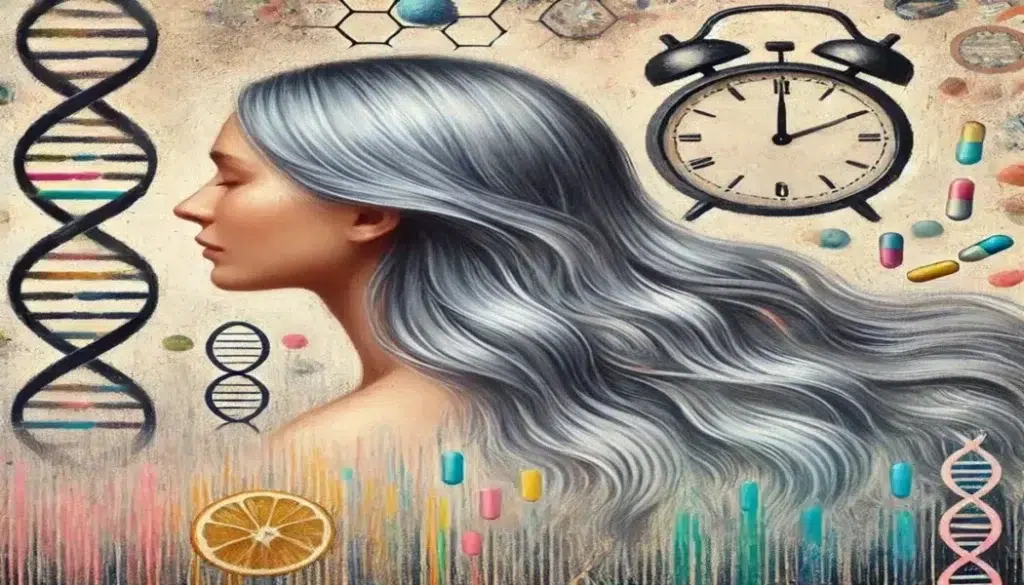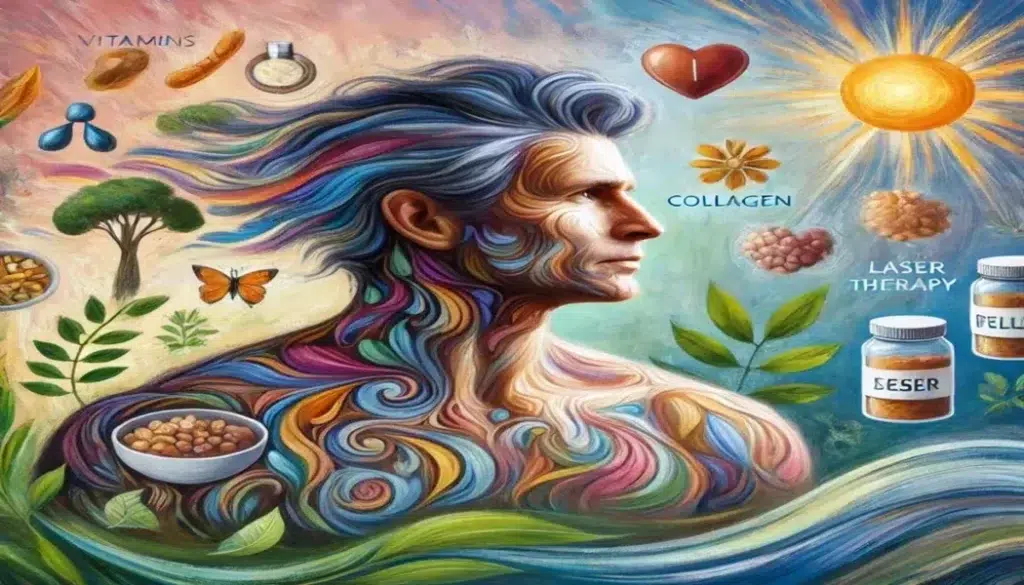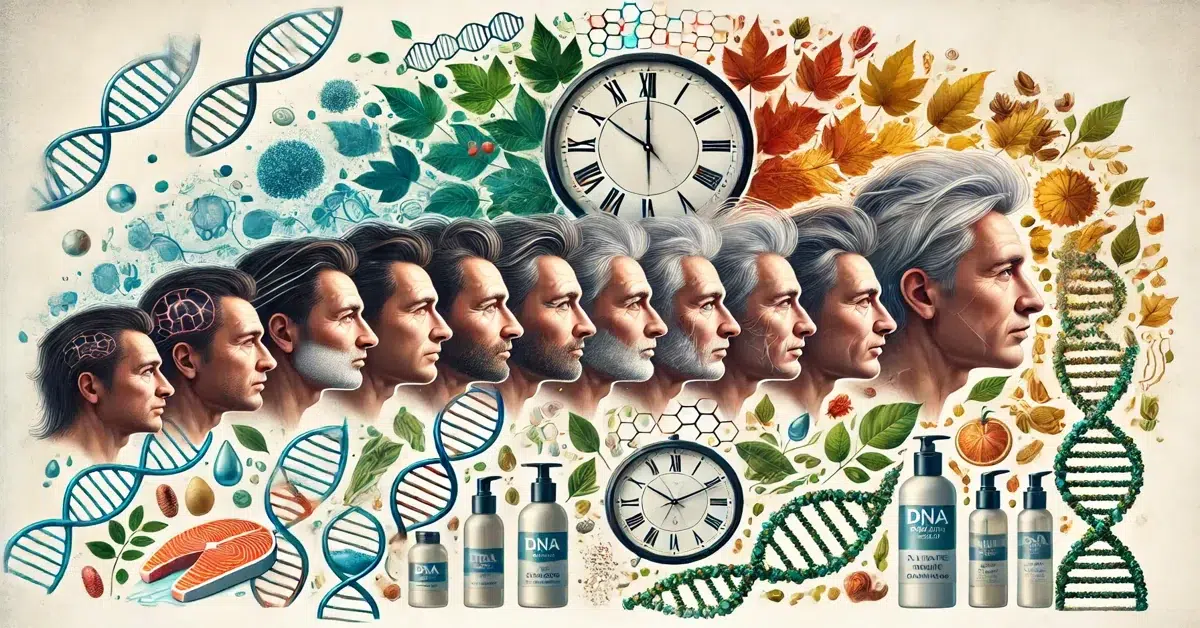Hair’s journey through time is more than just a few gray strands showing up. It’s a transformation from root to tip, with science diving into every strand. To really get into it, hair is mostly made up of keratin, a tough protein that’s like armor, keeping hair strong and resilient. As we age, this armor can get a bit compromised, leading to changes in how our hair looks and behaves.
Keratin isn’t the only player in the hair game. Melanin, the natural pigment that gives hair its color, gradually says goodbye as we get older. This is why those first grays appear, introducing a new hue to our natural palette. It’s not just about losing color; it’s a sign of what’s happening beneath the surface.

Hair structure itself changes with time. Follicles—the tiny pockets in your skin where each strand grows—may get tired, sometimes producing thinner or more brittle hair. It’s like the hair’s growth cycle decides to hit the brakes or take a longer nap than usual.
These biological shifts are part of the aging process, impacting not just our hair’s strength and color, but also its texture and feel. Sun exposure, pollution, and even diet can speed up these changes, making it vital to adapt our hair care regimes as we age. Focusing on maintaining hair health through the right care and nourishment can make a significant difference in how well hair faces age’s challenges.
🧬 Gray Hair Unveiled: Why and How It Happens
The mystery of gray hair usually kicks off with the loss of melanocytes, the little cells responsible for melanin production. These cells slow down over time and that’s when gray hair makes its grand entrance. But the plot thickens—genetics play a major role too. If your parents went gray early, chances are you might see those silver strands pop up sooner rather than later.
Misconceptions about gray hair can make the whole situation more puzzling. Heard the one about pulling a gray hair causing more to grow? That’s pure myth. Hair grows from follicles beneath the skin, and what’s happening there doesn’t work in a domino effect just because you tweezed a strand.
Genetic factors mean each person’s graying timeline is unique. While you can’t change your DNA, understanding these aspects can help manage expectations and care for graying hair more effectively.

Some folks experience premature graying, which can be linked to things like stress and vitamin deficiencies. Ensuring a balanced diet rich in vitamins B12 and D can be helpful. Ultimately, graying is natural, and embracing those strands is part of the journey for many.
Getting ahead with the right hair care products, such as those designed for gray or silver hair, can keep it looking shiny and vibrant. Look for sulfur-free shampoos and conditioners, and consider treatments specifically formulated for enhancing silver tones, to keep gray looking its best.
📉 Density and Volume: Why Hair Loses Its Lushness
Hair often starts losing its bounce and volume as follicles succumb to dormancy. This simply means they decide to stop producing new hair at their usual rate. As more follicles slow down or take a break, overall density decreases, leaving hair looking less full.
Our friendly hormones get involved too, particularly DHT (dihydrotestosterone). This hormone can cause follicles to shrink over time, especially in men. It’s also the reason behind the more obvious thinning patterns like receding hairlines.
Women experience changes mainly due to hormone fluctuations, especially during menopause. The drop in estrogen levels can lead to noticeable hair thinning. It’s not just about shedding; the hair that continues to grow might be finer and weaker.

This shift doesn’t happen overnight. Factors like stress, nutrition, and health conditions play roles in how and when changes take place. Paying attention to these can potentially help maintain the appearance of volume longer.
Maintaining hair thickness involves a bit of strategy. Using volumizing products, avoiding heavy conditioners, and considering treatments that stimulate the scalp can all help keep hair looking full. Consulting with a dermatologist or trichologist can give more tailored advice based on individual hair needs.
💧 Moisture and Strength: Addressing Dry, Brittle Hair
As hair gets older, retaining moisture becomes its new challenge, making dryness a common complaint. Sebum, the scalp’s natural oil, starts dwindling with age, leaving hair thirstier than before. This lack of natural lubrication makes strands more prone to breakage.
The result? Hair seems less lustrous and more prone to snapping or splitting at the ends. This change in texture can be frustrating, but it’s not without solutions. Hydration becomes the name of the game; think deep conditioning treatments and nourishing hair masks packed with moisture.
Maintaining your hair’s moisture balance involves adopting new care habits. Using a sulfate-free shampoo can minimize dryness, while leave-in conditioners and serums create protective barriers against environmental stressors.

Another angle is minimizing hair’s exposure to heat. High temperatures from styling tools can sap moisture, so dialing down that heat is vital. Letting hair air-dry more often or using a diffuser might be little adjustments that make a big difference.
Switching up products to focus on those designed for aging or dry hair can be an effective step. Look for ingredients like argan oil or shea butter, known for their hydrating properties.
🌿 Aging With Grace: Tips for Healthy Hair Throughout the Years
Navigating the hair-aging process involves understanding the hormonal changes that impact how our hair behaves. Estrogen and testosterone levels shift as we age, affecting the hair growth cycle. Hormones like DHT can lead to changes in hair thickness and health.
To slow down the effects of hair aging, consider embracing a holistic approach combining good nutrition, effective hair care routines, and targeted treatments. Protein-rich foods, essential fatty acids, and vitamins like biotin can feed the hair from the inside out, supporting growth and strength.

With innovative treatments such as PRP (platelet-rich plasma) therapy and low-level laser therapy making waves, options exist for those interested in medical interventions. These treatments can potentially boost hair vitality and promote a more youthful structure.
When it comes real-life day-to-day care, adapting routines can make a massive difference. Focus on scalp health with gentle massages to stimulate circulation. Less frequent heat styling and choosing tools set at lower temperatures can help preserve hair health and texture.
Choosing the right products is essential too. Opt for shampoos and conditioners enriched with keratin, collagen, and niacinamide, which are known for reinforcing hair strength. Hydration-focused serums and oils can also help older hair maintain its natural sheen and manageability.
Stay with us — the best is yet to come.
By following our advice, you’re doing the most you can for your hair.
Be the first to know when we publish new guides, tests, and proven strategies for stronger, healthier hair.
👉 Visit the About Me page to learn more about my journey, mission, and why helping people with hair health is so personal to me.
Want healthier, stronger hair? Discover 8 science-backed habits that protect your scalp and boost natural growth. Get your free PDF guide today!
Disclaimer: This article is for informational purposes only and is not a substitute for professional medical advice. Sensitive claims are supported with scientific references, and full product details can always be found on the official websites of the respective manufacturers or distributors.
Some links in this article are affiliate links. If you choose to make a purchase through them, I may earn a small commission at no extra cost to you — helping me keep HairGrowGenius running. Thank you for your support!

✅ FAQ – How Hair Ages: What Happens to Hair As We Age
❓ Is age-related hair thinning reversible with the right treatment?
Age-related thinning isn’t always fully reversible, but it can often be managed or slowed. Treatments that stimulate blood flow (like microneedling or minoxidil), support hormonal balance, and improve scalp health can significantly improve density and texture—especially when started early.
❓ Why does hair become wiry or coarse with age, even if it doesn’t fall out?
As we age, the scalp produces less sebum, which normally coats and softens the hair shaft. Combined with structural changes in the follicle and reduced melanin production, this leads to drier, rougher hair that feels wiry or brittle, even if the hair remains relatively thick.
❓ Does oxidative stress speed up the aging process of hair?
Absolutely. Oxidative stress from pollution, poor diet, UV radiation, and smoking can damage follicle cells and proteins like keratin and collagen, accelerating graying, thinning, and breakage. Antioxidant-rich hair care and diet can help protect against this.
❓ Can gray hair be prevented or reversed naturally?
While genetics play a dominant role, some evidence suggests that deficiencies in copper, B12, or catalase enzyme activity may contribute to premature graying. While reversal is rare, slowing it down with proper nutrition, stress reduction, and targeted supplements may be possible for some individuals.
Last updated: June 2025 based on latest research


Leave a Reply